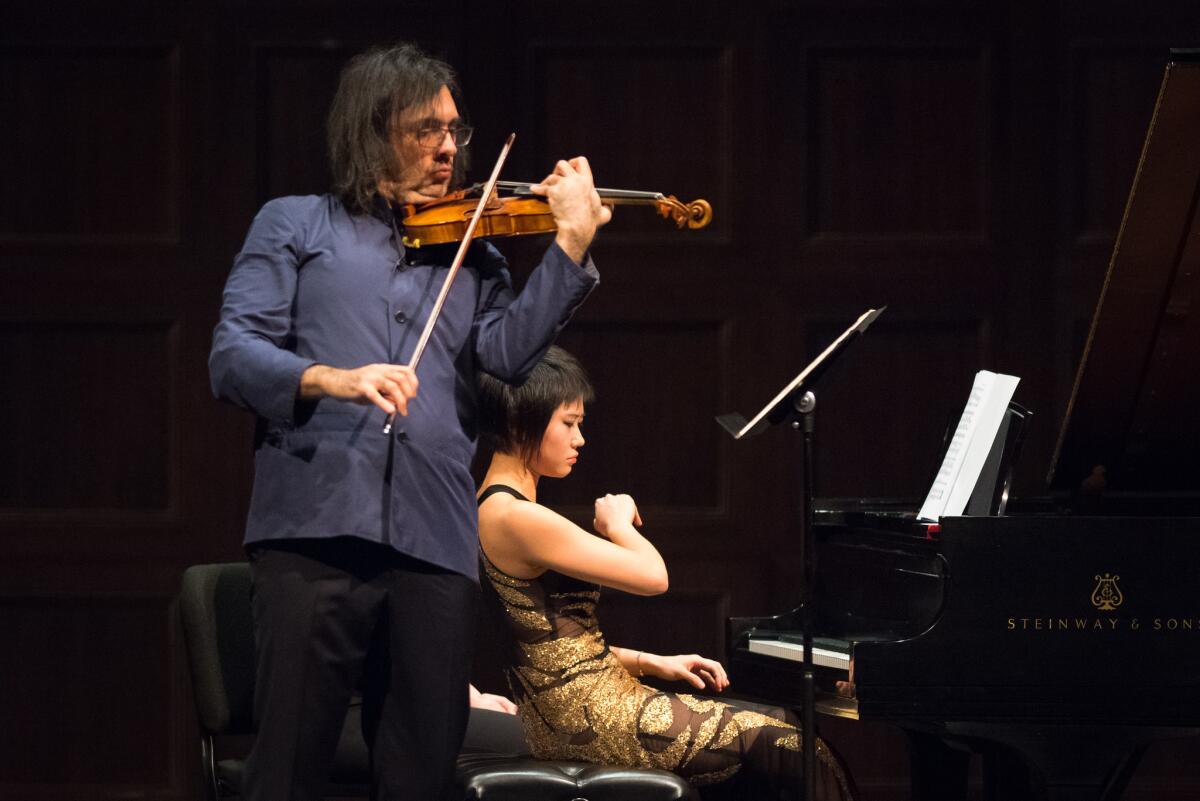Review: There is no disrupting Yuja Wang and Leonidas Kavakos

- Share via
Reporting from Santa Barbara — “Disruption” — in the hyped jargon of Silicon Valley, big business and politics — can too easily stand for deception, the overthrowing of expectations to get your way or to justify for messing up. Even when the intention is good, the very nature of having intention means revelation is unlikely.
This is the opposite of when artists learn from accidents. Revelation comes from not being ready, and that is what happened with a couple of fumbled page turns during the first half of a killer program given by two high-powered stars, violinist Leonidas Kavakos and pianist Yuja Wang at the Granada Theatre on Monday night.
This happened during a performance of Schubert’s Fantasie in C Major, which ended the first half of the program and would not be worth reporting had it not led to remarkable results.
The Fantasie began in appropriately ethereal realms. Wang made otherworldly tremolos and trills glitter like stars in the night sky. Kavakos’ tone has the character of striking high-grade silver sinew, ever beautiful, graceful and unbreakable, the ideal sound for Schubertean lyricism.
Late Schubert at his most heavenly, the Fantasie’s central variations section lifts the tragedy of a 30-year-old genius already suffering the distresses of syphilis, which would kill him a year later, to a melancholy cheer. Schubert ends by giving virtuosos the gift of high spirits.
An inexperienced page-turner’s fumbles did no real harm. The essence of all the above came through in compelling fashion. If there was a hint of uptightness, that was mostly evident in Wang’s curtain call, gloomy in comparison with her usual poise and buoyancy after intermission.
But first, how about a shout-out to page-turners? There is no more thankless task in all of music, sitting on stage, trying not to attract attention, getting the page turned at exactly the right moment for the pianist. (Some like it a little early, some a little late.) Repeat signs, two dots in the shape of a colon that require turning however many pages back to the beginning of a section, are a nightmare. They are hard to see, especially when sitting some distance from the piano. Stage lights can be in your eyes. Scores have different weights, different textures.
Everything must be done at split second. Nerves of steel are required. There is little reward. Things can, and do, more often than you might think, go wrong.
Still there were clearly nervous-making moments. Kavakos and Wang had placed the Schubert as an episode of lyric tranquillity between tense early 20th century violin sonatas. Janácek’s Violin Sonata has very sharp rhythmic edges. Daring to open the evening with it was a kind of mild disruption, a testing of the waters and a bit of a jolt.
Wang and Kavakos have been touring this program (they played it the night before in Costa Mesa), but you could still sense the tension of the opening.
That tension only helped to underscore that even in the most secure performers, underlying fragility is inescapable. Chemistry on stage plays such a great role that we need a new discipline of chemo-musicology. Conservatory students might benefit from courses in chemo-musicianship.
Wang and Kavakos have a chemistry. She often dominated with the sheer power of her playing, but he was responsible for the subtle fluidity that makes their collaboration exceptional. Usually the pianist supports the violinist, but Kavakos, a generation older than Wang, seemed here the rock.
The pair returned after intermission for Debussy’s Violin Sonata and Bartók’s First Violin Sonata joined by a new page-turner. They seemed newly bonded, with new intent to make the music and the moment matter, to be in the here and now and not the score.
Wang had also changed gowns, to something so tight as to seem like a second skin. Maybe that gave her a sense of freedom. Then again, so many other things can have their psychological effects as well.
The hall and the audience play a role. Wang happened to be in a comfortable setting, performing as part of the UC Santa Barbara Arts & Lectures series that first brought her to Santa Barbara as an unknown emerging artist. It’s where she has felt confident enough to try out new repertory.
In the Debussy, Wang emphasized the grave gorgeousness of the French composer’s harmonies, while Kavakos spun ever more exquisite silver. But Bartók’s gripping, experimental, unsettled sonata became the vehicle where both players found themselves by losing themselves. I don’t think it would have made any difference had the music at this point been flying all over the stage.
The sonata brings up serious issues as it strikes out into new sound realms, its passionate lyricism highly unpredictable. Kavakos and Wang had been technically brilliant all night no matter what, and everything made musical sense.
The Bartók did not make reasonable sense. The first movement erupted in shocking emotion. The slow movement went where the mind goes when left to its own mysterious devices. The Finale was an eruption of I don’t know what. The effect was not of Kavakos or Wang in extraordinary control (which they, of course, were) but of Bartók laid bare.
We don’t yet have the science to dissect how much a page-turner had to do with this ultimate and revelatory loss of intention or what kind of chemo-musical reaction occurred to make a great performance. But something did happen. And it wasn’t disruption but eruption.
ALSO
Thomas Adès and the L.A. Phil find life in the Dance of Death
L.A. Opera wins two Grammys for ‘Ghosts of Versailles’
Jane Kaczmarek and her complete departure from ‘Malcolm’
Al Pacino and the role that pulled him to the Pasadena Playhouse stage
‘Zoot Suit’: How Latino theater born in the farm fields changed L.A. theater











